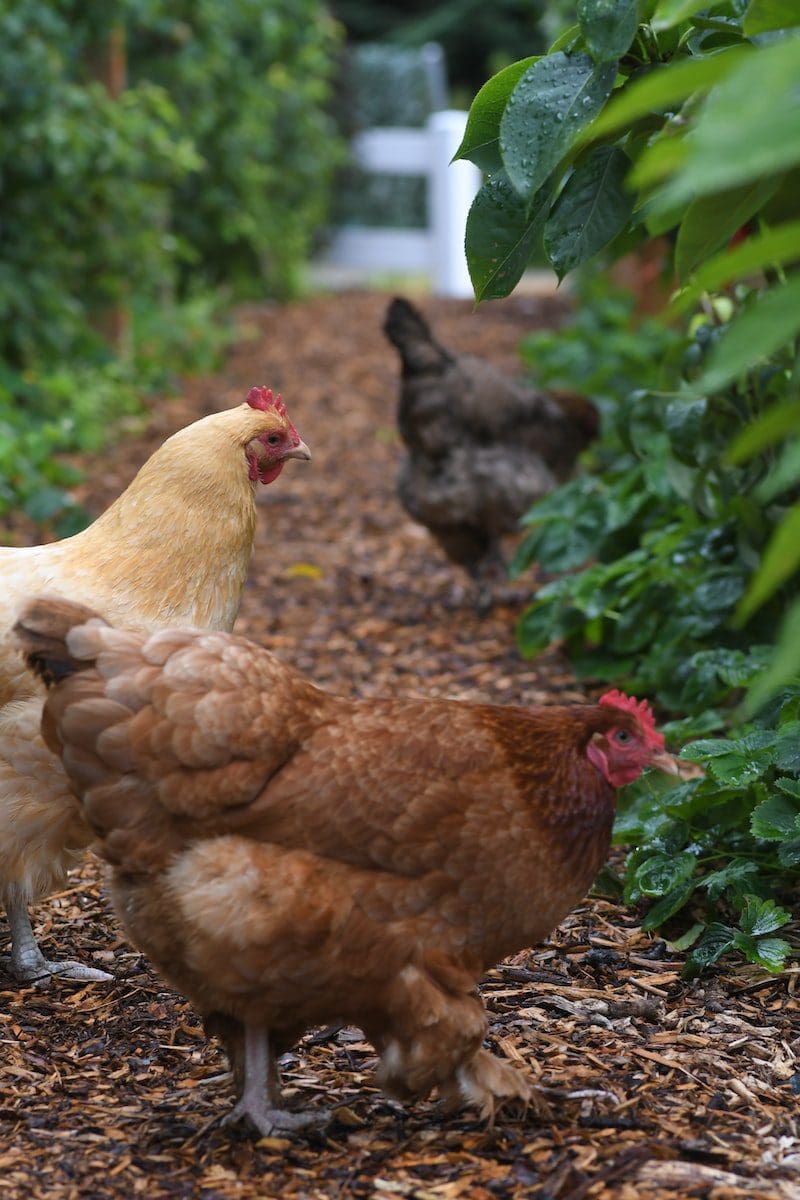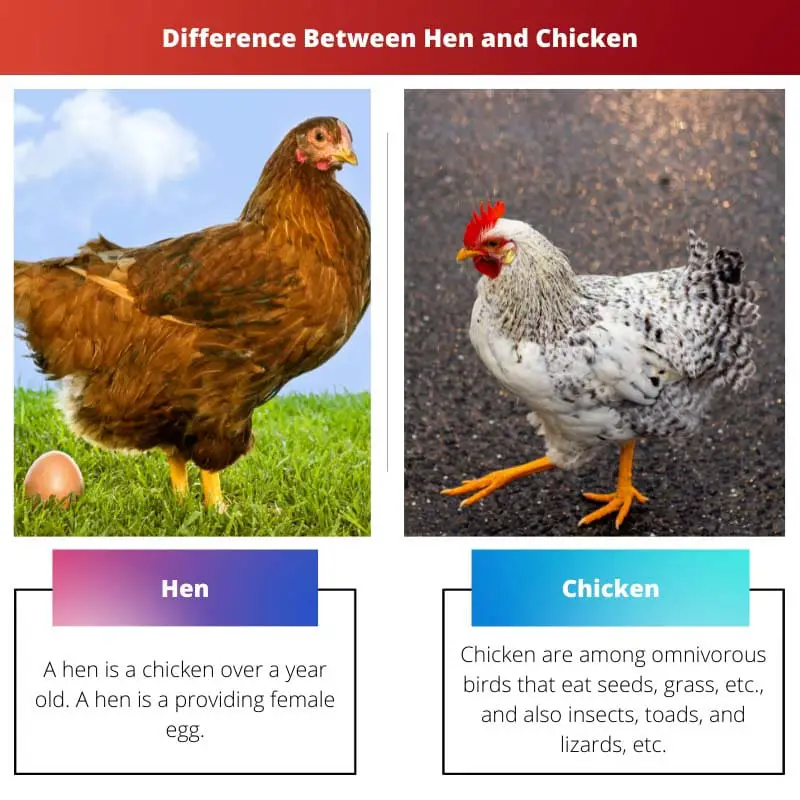There are certain birds we see every day that are similar. We might think of them as the same, but they are not. Most of the time, this is because they belong to the same species having similar appearance or features. The best examples of such birds are Hen and Chicken.
Most people get confused between both birds and think of them as the same, as they look the same, belong to the same species, and have similar other characteristics but are not the same. They both are different from each other.
Key Takeaways
- Chickens refer to both male and female members of the Gallus gallus domesticus, while hens specifically designate the female birds.
- Hens lay eggs and are responsible for incubating them, whereas male chickens, known as roosters, protect and court the hens.
- People raise hens primarily for egg production, while they may raise both hens and roosters for meat consumption.
Hen vs Chicken
“Hen” is a female chicken that is over a year old and has reached sexual maturity. Hens are used for egg production and are kept on farms or in backyard coops. “Chicken” is a general term that is both male and female chickens. Male chickens are called roosters or cocks, while female chickens are hens.

A hen is an adult female chicken that is used mostly for eggs and meat. A hen is always a chicken. It mostly depends on the type of bread when they’ll start laying eggs. Some breeds start breeding early, while some may take more time in comparison.
They are using domestic pets for several reasons, the main being laying eggs and breading. They don’t require a rooster for this purpose. It is believed they evolved from dinosaurs.
Chicken is an omnivore’s bird, meaning they eat meat as well as vegetables. Males and females can both be chickens. They can also lay eggs. They have great memories that they can even remember 100 different faces. They make noises in the morning when the sun rises.
They are also used as meat for eating. They also dream while sleeping like humans. Different species of chickens lay eggs of different colors.
Comparison Table
| Parameters of Comparison | Hen | Chicken |
|---|---|---|
| Physical body | They are fully grown. | They are still growing. |
| Gender | Always a female | Can be a male or female |
| Fertilizing | Can lay eggs | Can or cannot lay eggs. |
| Species | Varies | Gallus domesticus |
| Relation | They are always chicken. | They may or may not be a hen always. |
What is Hen?
A hen is a chicken over a year old. A hen is a providing female egg. Some breeds of them start laying eggs in the 15 or 16 weeks, while some take time and start laying in their 20th week.
Therefore fertilizing entirely depends upon the breed of hen. Some of its breeds continue laying eggs every day, while some might lay after a day or two or even change the pattern, it depends upon them.
Middle-aged hens lay more eggs, and older and younger ones lay comparatively fewer eggs. The speed of laying also depends upon the weather and environment.
It is said that rooster presence is not required for laying the eggs, although it might help in increasing the chances but is not compulsorily required. Some even said that a chicken becomes a hen as soon as it starts laying eggs, while some argue with this statement.
They are also a good source of meat; therefore, it is also one of the reasons to domesticate them. It is eaten mostly as it is rich in protein and considered to be the healthiest for gaining mass or weight.

What is Chicken?
Chickens are omnivorous birds that eat seeds, grass, etc., and also insects, toads, lizards, etc. Chicken can remember the faces of their family or, in general, the faces of more than 50 people. Not only this, along with human faces, they also recognize different animals.
Some people believe that chickens are colorblind, which is not correct at all. They have a very strong color vision, even better than human vision. They can communicate with different vocalizations, each with its own specific meaning.
Studies have proven that the ancestors of chickens are dinosaurs, which is why both have a similar physical appearance. Unlike hens, there are varieties of chicken all over the world. There are more than 30 million chickens with their specific characteristics.
People thought chickens were dumb, but then recent studies have proven this wrong, and chickens are smarter than expected, can solve problems, and have super sensory powers.
Chickens also teach their babies what to eat and what to avoid, and other food-related information. Chicken are playful and like to play most of the time. They can run faster and are also able to fly to a certain height. It is believed that some species of chickens are becoming extinct.

Main Differences Between Hen and Chicken
- A Hen is a grown-up female that can lay eggs and is also used for meat, while chickens are babies of the female (a hen) that are mostly used for meat but may or may not lay eggs.
- They also differ in terms of gender. A hen is a female, always a male can never be a hen, whereas a chicken can either be a male or female. For example, a rooster belongs to a chicken family and is a male capable of fertilizing.
- All the chickens have not been considered as hens as not all of them have the capabilities of hens, while all the hens can be considered or called chickens.
- Chicken is from Gallus domesticus species exactly, whereas Hen is from various species.
- Chicken is a relatively broader term that includes more than one type of bird, such as rooster, capons, pullet, etc., while a hen is not a broader term. It is just a fully-grown fertilizing chicken.


The article effectively explains the different features and behaviors of hens and chickens, shedding light on their respective roles in egg-laying and other functions.
The information about the evolution of chickens from dinosaurs adds an interesting perspective to the topic. The article presents valuable insights.
I appreciated the in-depth explanations about the differences between chickens and hens. The details presented in the article are educational and engaging.
This article provides comprehensive information on hens and chickens, particularly concerning their roles and characteristics. It is an enlightening read.
The comparison table was particularly useful in understanding the differences between hens and chickens. The article provides great clarity on the topic.
The article effectively highlights the unique features and behaviors of both hens and chickens, offering valuable insights into these birds.
The information about chickens having the ability to recognize different faces and animals is quite intriguing. The article provides meaningful insights.
It was surprising to learn that hens are specifically the female birds while chickens to refer to both male and female. The article is quite informative and insightful.
I couldn’t agree more, Kallen. It’s indeed fascinating to know the differences between hens and chickens, especially in terms of their roles in egg production and breeding.
I appreciate the detailed explanations provided about hens and chickens. Knowing the specific characteristics of each helps in better understanding these birds.
I found this article to be a great resource for understanding the characteristics and distinctions between hens and chickens. It contributes to increasing knowledge on the topic.